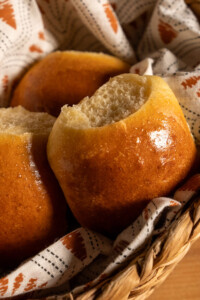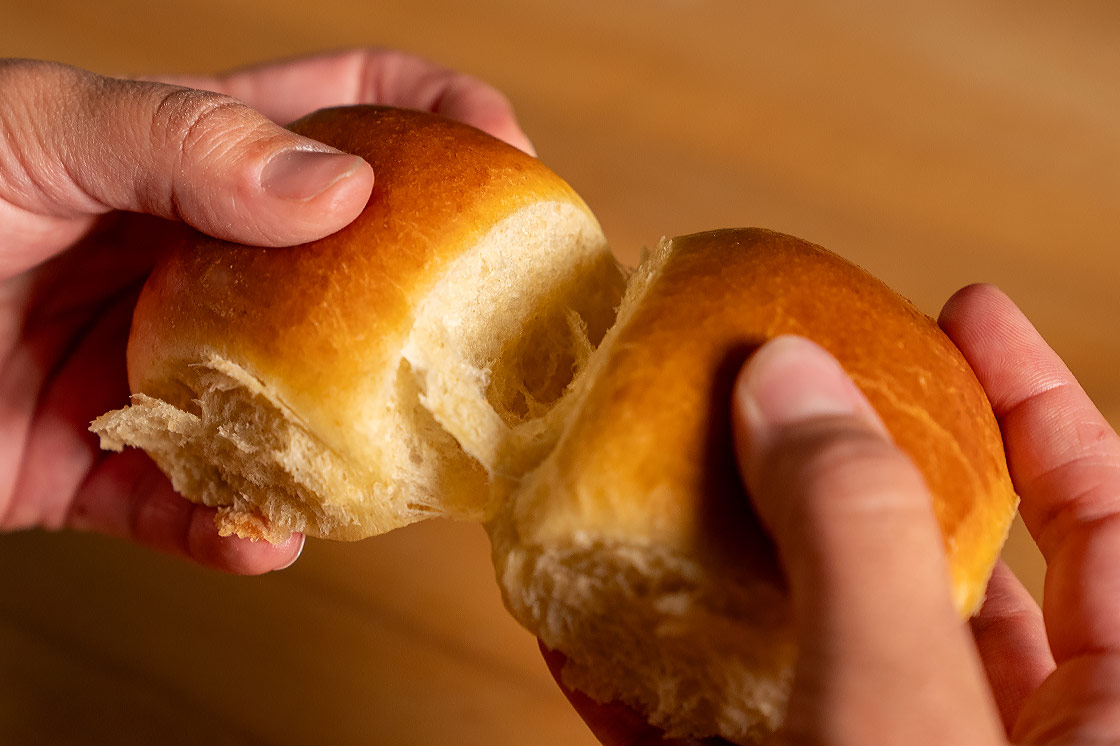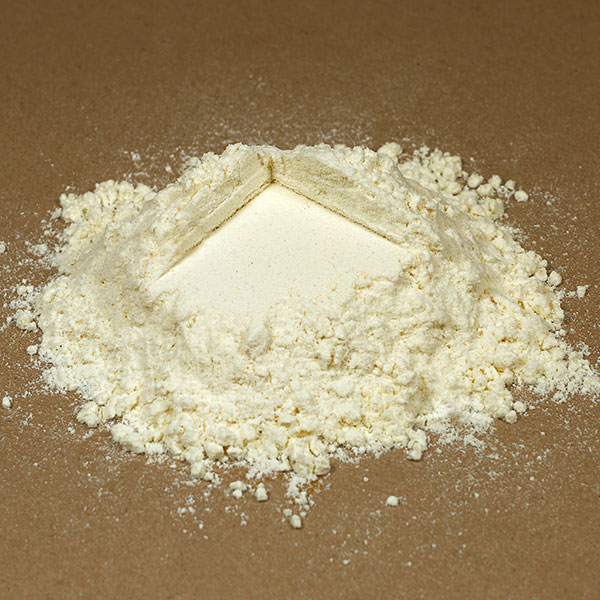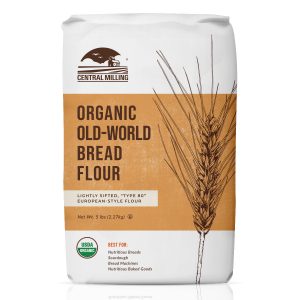
Imagine you’re sitting at your dining table, family gathered around. Maybe there’s a turkey on the table…There are definitely candles involved. As the sides are being passed around, a basket of golden, pillowy rolls is placed before you. The warm smell of butter fills your nose. There’s no way you’re only taking one…
These pull-apart dinner rolls are special for a few reasons. For one, they’re made with our Organic Old-World Bread Flour that is milled whole and then sifted to remove some of the the brand and germ. What you’re left with is an amazingly flavorful and nutritious wheat flour that performs a lot like a white bread flour. Secondly, they’re brioche – a soft and slightly sweet French bread that’s enriched with butter. Because who doesn’t love more butter in their baked goods? And last, but not least, these dinner rolls are made with a preferment called a sponge. Although not all brioche is made with a preferment, we think the extra flavor from the preferment (using the same Old-World Bread Flour) really takes this formula over the top.
Thanksgiving dinner, here we come!
Formula
Number of Units: 30 rolls / Unit Weight: 50 grams / Total Weight: 1500 grams
| PREFERMENT | ||
|---|---|---|
| Sponge | 12 hrs at 70˚ F | |
| Baker’s % | Weight (grams) | |
| Organic Old-World “Type 80” Bread Flour | 100 | 155 |
| Water | 62 | 96 |
| Yeast | 0.1 | 0.2 |
| Salt | 0.3 | 0.5 |
| Total | 162.4 | 251 g |
| FINAL DOUGH | ||
|---|---|---|
| Baker’s % | Weight (grams) | |
| Organic Old-World “Type 80” Bread Flour | 100 | 502 |
| Salt | 2.2 | 11 |
| Sugar | 20.0 | 100 |
| Instant Yeast | 1.5 | 8 |
| Eggs | 50.0 | 251 |
| Butter | 55.0 | 276 |
| Water | 20.0 | 100 |
| Sponge | 50.0 | 251 |
| Total | 298.7 | 1500 g |
| TECHNICAL | ||
|---|---|---|
| Preferment Type | Sponge | |
| Preferment – Time & Temp | 12 hrs @ 70° | |
| Desired Dough Temp | 76° | |
| Mixing Type | Stand Mixer | |
| First Speed* | 5 min | |
| Second Speed* | 15–18 min | |
| Gluten Structure | Improved | |
| First Fermentation | 1.5 hrs | |
| Second Fermentation | 12 hr in the fridge | |
| Dividing | 50 g | |
| Pre-shaping | Round | |
| Resting Time | 20 min | |
| Shaping | Round | |
| Final Fermentation | 3–4 hrs | |
| Baking** | 18–25 min | |
| Steam | No | |
*Mixing time can vary depending on the mixer.
**Baking time and temperature can vary depending on your oven.
Timing
Total Time: ~2 days / Active Time: 40 min / Baking Time: 18–25 min
Process
Two Evenings Before Baking
In a medium bowl, mix all the ingredients for the sponge together until they are thoroughly combined and there is no visible dry flour in the bowl.
Cover the bowl in plastic wrap and let it sit in a warm place for 12 hours.
Day Before Baking
Scale all the ingredients beginning with the butter, let the butter sit out in a warm place while you are scaling the rest of the ingredients. The butter should be cold to the touch but pliable, when you push your finger into it, it will feel cold but soften and show an indent.
Add the sponge, flour, salt, sugar, yeast, eggs, a small handful of butter, and most of the water to the mixing bowl. Using a dough hook, mix on low speed for five minutes. Add the last little bit of water near the end of the five minutes. Make sure to stop and scrape the bowl as needed.
After 5 minutes on low speed, kick it up to medium-high speed and mix for about 15–18 minutes to develop the gluten. This process takes a long time on a stand mixer, so be patient. It is important to get the gluten developed before adding the rest of the butter.
Once the dough is fully mixed, it’s time to add the butter. With the mixer running slowly add the butter a few chunks at a time, allowing the dough to absorb the butter before adding more. Stop and scrape down the sides of the bowl as/if needed. Once all the butter is in the dough, the dough should feel strong, look shiny, and there should be no visible streaks of butter.
Transfer the dough to a oil-lined container or bowl and cover. Let the dough ferment at room temperature for an hour and half. Give the dough a quick stretch and fold and put it in the fridge overnight. If you’re not familiar with how to complete a stretch and fold, here’s how:
Let the dough fall from the bowl onto the table, scraping out the remaining dough if needed.
Take the top part of the dough, stretch it away from yourself and then fold it back on to the dough (towards yourself) about 1/3 of the way. Now, take the bottom of the dough and do the opposite: stretch it towards yourself and then fold it back over the first fold to the end of the dough.
Do the same to the left and right side.
Next, take the top of the dough mass and fold it over the center, in thirds, and continue the motion until it has rolled over with the seam-side down and smooth side up.
Slide both hands underneath the halfway point of the dough, vertically. Lift it up and place it back in the bowl allowing the ends to tuck themselves under, leaving a smooth surface on top.
Bake Day
Pull the dough from the fridge and dump it out on a floured work surface. Scale out 30 pieces of dough at 50 grams each. Quickly round each one and let them rest for 20 minutes before final shaping.
While they rest, prepare a 13″ x 18″ sheet pan by lining it with parchment and spraying it with oil.
After 20 minutes, shape the rolls into rounds once more and place them on the sheet pan about ½” apart. All 30 rolls should fit on the sheet pan together.
Place your rolls in a warm place to proof. You may need to cover them with a tea towel or plastic wrap to prevent a skin from forming. They will take a few hours to fully proof. Once they are fully proofed they will look full in the pan and be touching with small gaps between the rolls. When you poke the rolls with your finger, they will hold the impression.
Preheat your oven to 375˚ F, if you haven’t yet.
Whisk up one egg to make an egg wash. Brush the egg wash onto the rolls before putting them in the oven.
Bake at 375˚ F for 18–25 minutes until golden brown, turning them halfway through.
Let the rolls cool slightly on the pan before removing them. Pile them into a basket and cover with a towel until ready to serve (still warm, ideally).







